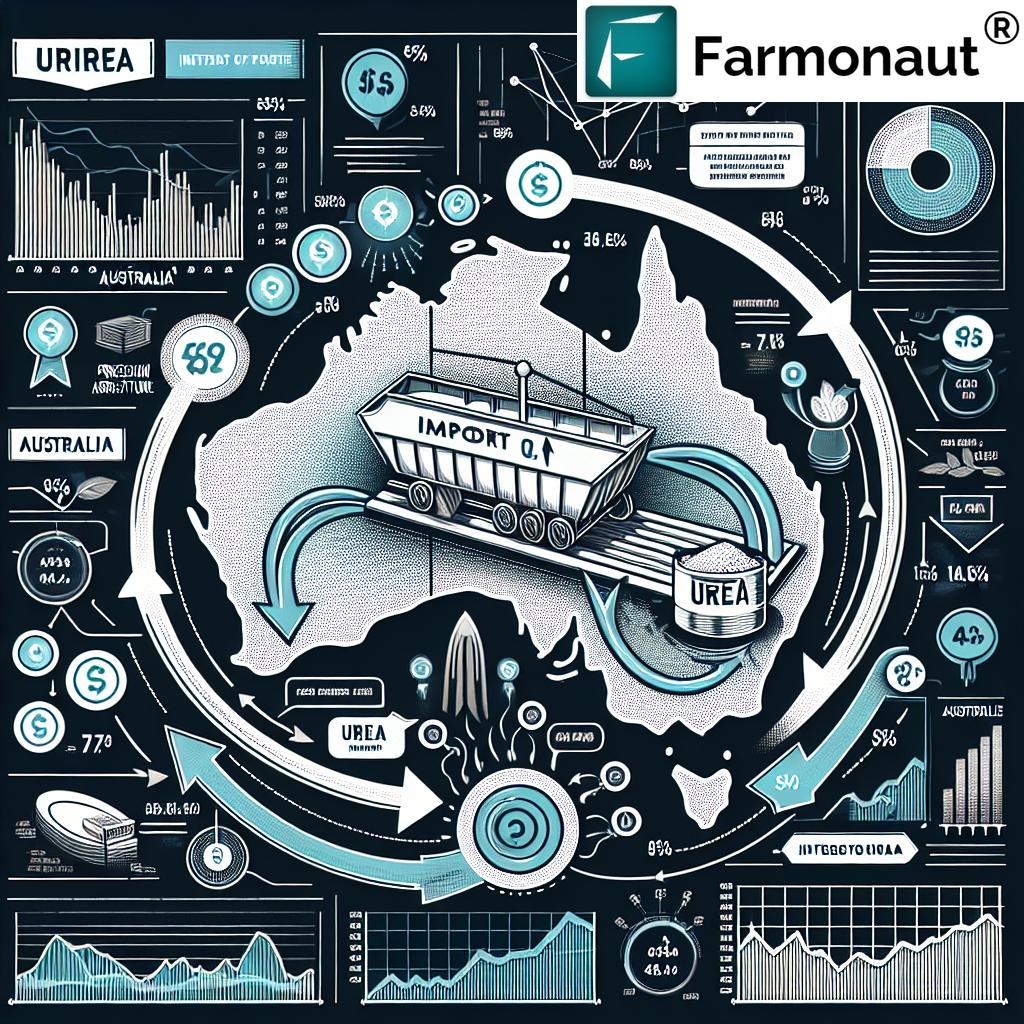Unleashing Agricultural Potential: Australia’s Urea Imports Reshape Global Fertilizer Market Dynamics

In recent years, Australia’s urea imports have been making waves in the global fertilizer trade, significantly impacting fertilizer market trends and reshaping the agricultural supply chain. This shift in Australia urea import trends is not just a local phenomenon but has far-reaching implications for global fertilizer market dynamics and the broader agricultural commodities sector.
The Rising Tide of Australia’s Urea Demand
Australian agriculture has long been a cornerstone of the nation’s economy, and its growing demand for fertilizers, particularly urea, is a testament to the sector’s expansion and intensification. The surge in Australia urea imports can be attributed to several factors:
- Increasing crop production to meet global food demands
- Adoption of advanced farming techniques requiring precise nutrient management
- Efforts to improve soil health and crop yields in challenging climatic conditions
This growing urea demand has positioned Australia as a significant player in the global fertilizer trade, influencing prices and supply chains worldwide.
Impact on Global Fertilizer Market Dynamics
The surge in Australia urea imports has sent ripples through the global fertilizer market, affecting everything from pricing to production strategies. Here’s how:
- Price Fluctuations: Increased demand from Australia has contributed to upward pressure on global urea prices.
- Supply Chain Reconfigurations: Major urea producers are reassessing their distribution networks to cater to the Australian market.
- Production Boost: Some fertilizer manufacturers are ramping up production to meet the growing Australian demand.
These changes in global fertilizer market dynamics are prompting stakeholders across the agricultural commodity supply chain to adapt their strategies.

Implications for the Agricultural Supply Chain
The evolving landscape of Australia urea import trends is having a profound impact on the agricultural supply chain, both domestically and internationally. Key areas affected include:
- Logistics and Transportation: Increased imports are putting pressure on port facilities and inland transportation networks.
- Storage and Distribution: New infrastructure investments are being made to handle the growing volumes of imported urea.
- Farm-Level Operations: Australian farmers are adapting their practices to optimize the use of imported fertilizers.
These changes are reshaping the farm input market in Australia and influencing global supply patterns.
Nitrogen Fertilizer Supply and Market Outlook
The surge in Australia urea imports is particularly significant for the nitrogen fertilizer supply sector. As one of the most widely used nitrogen fertilizers, urea plays a crucial role in global agriculture. The nitrogen fertilizer market outlook is being shaped by Australia’s growing demand, with several key trends emerging:
- Increased production capacity in key exporting countries
- Technological advancements in urea manufacturing to meet stringent quality standards
- Growing interest in sustainable and environmentally friendly nitrogen fertilizer alternatives
These trends are influencing investment decisions and research priorities in the global fertilizer industry.
Farm Input Cost Analysis: The Australian Perspective
For Australian farmers, the changing dynamics of urea imports have significant implications for their operations. A comprehensive farm input cost analysis reveals:
- Potential fluctuations in fertilizer prices affecting overall crop input costs
- The need for strategic planning in fertilizer procurement and application
- Opportunities for cost optimization through bulk purchasing and cooperative arrangements
Understanding these factors is crucial for Australian farmers to maintain competitiveness in the global agricultural market.
Crop Input Optimization Strategies
In response to the changing fertilizer landscape, Australian farmers are adopting innovative crop input optimization strategies. These include:
- Precision Agriculture: Utilizing technology to apply fertilizers more efficiently
- Soil Health Management: Focusing on long-term soil fertility to reduce fertilizer dependence
- Alternative Nutrient Sources: Exploring organic and bio-based fertilizers as complements to urea
These strategies aim to maximize the benefits of imported fertilizers while minimizing environmental impact and production costs.
The Role of Technology in Australian Agriculture
As Australian agriculture adapts to changing fertilizer market dynamics, technology is playing an increasingly important role. Farmers are leveraging advanced tools and platforms to optimize their fertilizer use and crop management practices. One such innovative solution is provided by Farmonaut, a leading agricultural technology company.
Farmonaut offers a range of tools to help farmers make data-driven decisions:
- Satellite-based crop monitoring
- Weather forecasting and analysis
- Soil health assessment
These technologies enable farmers to fine-tune their fertilizer application, potentially reducing costs and improving yields. To explore these solutions, visit the Farmonaut web app or check out their mobile applications:
Future Outlook: Australian Agriculture and Global Fertilizer Markets
As we look to the future, the relationship between Australian agriculture fertilizer demand and global fertilizer market dynamics is likely to remain closely intertwined. Key factors that will shape this relationship include:
- Climate change and its impact on agricultural practices
- Technological advancements in fertilizer production and application
- Shifts in global trade policies affecting fertilizer imports and exports
- Growing emphasis on sustainable and environmentally friendly farming practices
For stakeholders across the agricultural sector, staying informed and adaptable will be crucial. Leveraging data and technology, such as the solutions offered by Farmonaut’s API, can provide valuable insights for navigating these evolving market dynamics. For more information on integrating these tools into your agricultural operations, refer to the API Developer Docs.
Conclusion
The rise in Australia urea imports represents more than just a shift in trade patterns; it signifies a transformation in global agricultural practices and fertilizer market dynamics. As Australian farmers continue to drive demand for urea and other fertilizers, the ripple effects are being felt throughout the global fertilizer trade and agricultural commodities markets.
This evolving landscape presents both challenges and opportunities for farmers, fertilizer producers, and other stakeholders in the agricultural sector. By staying informed about fertilizer market trends, adopting innovative technologies, and implementing smart crop input optimization strategies, industry players can navigate these changes successfully.
As we move forward, the interplay between Australian agriculture and global fertilizer markets will undoubtedly continue to shape the future of farming practices and food production worldwide. Embracing technology and data-driven decision-making will be key to thriving in this dynamic environment.


